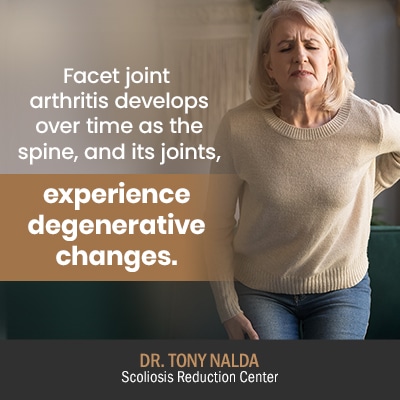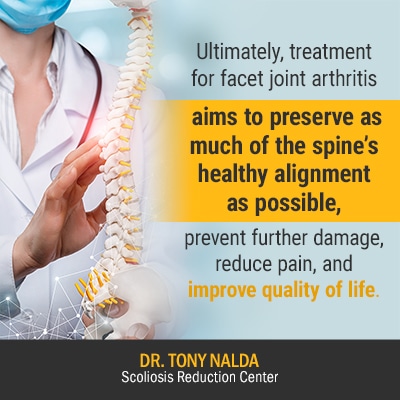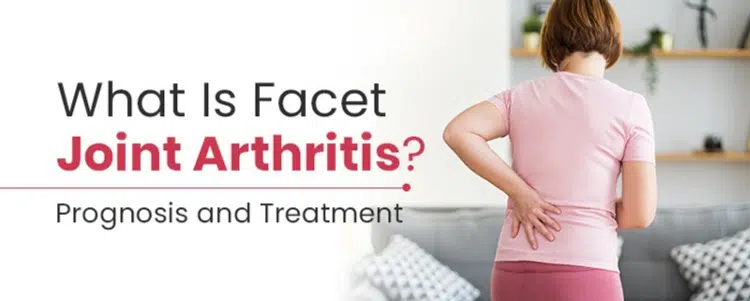The facet joints of the spine help enable flexible movement, spinal stability and prevent injury from over-twisting. As each spinal segment comprises two vertebral bodies, an intervertebral disc, and a pair of facet joints, a type of three-joint structure is formed, with each structure’s health and function affected by the condition of the other structures. Keep reading to find out how facet joint arthritis affects the spine.
Facet joints are spinal joints that facilitate flexibility and stability. Facet joint arthritis develops when the cartilage covering the joint ends starts to erode and thin out; this can cause painful swelling, stiffening, and inflammation of the joints. Treatment can involve a combination of therapies.
Let’s start our discussion of facet joint arthritis by touching on some basic spinal anatomy.
Spinal Anatomy
A healthy spine enables us to stand upright, practice good posture, engage in flexible movement, and absorb/distribute mechanical stress incurred during movement to avoid exposing a spine section to adverse tension and uneven wear.
The main spinal sections consist of the cervical spine (neck), the thoracic spine (middle/upper back), and the lumbar spine (lower back).
The spine has natural and healthy curvatures, which is why when viewed from the sides, it has a soft ‘S’ shape, and when viewed from the front and back, it appears to be straight.
Each section of the spine has a distinct curvature type that either bends forwards or backward, and for the spine to function optimally, it needs to maintain its natural curvatures.
There are several conditions the spine can develop that involve a loss of these healthy curves as the spinal vertebrae (bones of the spine) become misaligned.
The vertebrae are separated by intervertebral discs that provide cushioning between adjacent vertebrae, so friction isn’t generated during movement, enable spinal flexibility, and act as the spine’s shock absorbers.
The spine’s facet joints are small joints located on both sides at each vertebral level. As mentioned, these joints help facilitate spinal flexibility and the ability to bend and turn, as well as spinal stability by preventing injury from over-turning or twisting.
Each side of a facet joint has a layer of cartilage that enables the smooth sliding and gliding of the vertebrae during movement, but once that cartilage starts to erode, problems can occur.
Arthritis is somewhat of an umbrella term that references swelling and tenderness of one or more of the body’s joints. Now that we have a basic understanding of spinal anatomy and function, let’s move on to the specifics of facet joint arthritis.
What is Facet Joint Arthritis?

Facet joint arthritis develops over time as the spine, and its joints, experience degenerative changes.
While a certain amount of spinal degeneration is to be expected with age, additional factors such as lifestyle and various spinal conditions can also cause excessive amounts of spinal degeneration and arthritic changes.
The cumulative effect of certain lifestyle choices such as leading a sedentary lifestyle, carrying excess weight, chronic poor posture, and incorrectly lifting heavy objects can contribute to spinal degeneration and arthritic changes over time. These conditions develop by exposing the spine to uneven pressure and wear.
The most common types of arthritis are rheumatoid arthritis and osteoarthritis. Osteoarthritis can cause the cartilage that encases the ends of the facet joints to break down. Rheumatoid arthritis is a disease that causes the immune system to attack the linings of the facet joints, leaving them vulnerable to inflammation and weakness.
When one or more of the spine’s facet joints develop arthritis, it can cause weakness and inflammation and affect the integrity of the parts they are attached to, such as the vertebral bodies and their intervertebral discs.
When a facet joint and its surroundings become inflamed, it can encroach upon the spaces within and around the spine. This can mean less room for important spinal nerves and irritating nerve endings, known to cause varying pain levels.
This leads us nicely into the next topic of what it’s like to live with facet joint arthritis.
What Does Facet Arthritis Feel Like?
While every case is unique and will produce its own set of symptoms, facet joint arthritis is often associated with pain at the site and other areas of the body when nerves are involved.
In addition, the severity and location of facet joint arthritis-related pain will depend on its location within the spine.
For people with cervical facet joint arthritis (arthritis of the facet joints in the neck), pain can radiate towards the back of the head, ears, or shoulders. Pain from lumbar facet joint arthritis can involve localized pain in the lower back and radicular pain in the buttocks, hips, or thighs.
Facet joint arthritis pain tends to increase with certain movements after long periods of inactivity or sleep and can make it difficult to stand fully upright and stand up from a seated position.
In addition, due to the joint stiffness that arthritis is known to cause, a decreased range of spinal flexibility can come into play, particularly with twisting motions. This decline in spinal flexibility can cause the sensation of having to turn the entire body to the left or right, rather than how a healthy and flexible spine can facilitate a smooth twisting motion to either side.
Risk factors for developing facet joint arthritis can include age, spinal injury, degenerative disc disease (DDD), chronic poor posture, and a genetic predisposition to developing degenerative arthritis.
When it comes to facet joint arthritis prognosis, factors such as patient age and overall health, causation, the degree of nerve involvement, and condition severity guide the design of effective treatment plans and factor into the ultimate prognosis.
Additional Reading: Cervical Radiculopathy: Symptoms, Causes, and Treatments
Facet Joint Arthritis Treatment
When it comes to facet joint arthritis treatment, many conservative treatment options are non-invasive, effective, and involve integrating several different therapies for the best results.
Here at the Scoliosis Reduction Center®, my treatment approach is conservative, chiropractic-centered, and integrative.
While there are never treatment guarantees for patients with facet joint arthritis, I let patient factors and the specifics of their condition, particularly causation and severity, inform the crafting of a customized treatment plan.
Alternating heat/cold therapy can help reduce inflammation and swelling, relax muscles, increase circulation, and relieve pain.
Guidance on lifestyle factors that can exacerbate the condition is also important. This guide can include weight management, education on the importance of proper posture, the ergonomics of heavy lifting, and integrating condition-specific therapeutic exercise, where physical therapy comes in.
Once harmful lifestyle factors are addressed, the spine is exposed to less stress/uneven wear, and this helps create an environment inside the body that’s more conducive to healing and will respond better to treatment.
Physical therapy involves the application of condition-specific exercises with corrective potential by helping to keep the spine and its surroundings as strong, flexible, and loose as possible.
When the core and spinal muscles are strengthened, the pressure is taken off the spine’s structures, as strong surrounding muscles help with spinal support/stabilization.
There is also the option, in special cases, of using a corrective brace to help with spinal support and pain relief during treatment, but bracing is not a typical form of treatment for facet joint arthritis.
While chiropractic care can’t rebuild lost cartilage, it can work towards realigning the spine by manipulating the position of affected vertebral bodies through various spinal-manipulation techniques.
When it comes to disc-related issues, particularly when facet joint arthritis is caused by degenerative disc disease, spinal manipulation can also assist in improving disc health by repositioning vertebrae so there is less pressure on the discs, and increasing circulation in an affected disc’s surroundings can also help with disc nutrition, rejuvenation, and hydration.

Ultimately, treatment for facet joint arthritis aims to preserve as much of the spine’s healthy alignment as possible, prevent further damage, reduce pain, and improve quality of life.
Conclusion
Facet joint arthritis occurs when the small facet joints of the spine experience degenerative changes that involve a loss of important cartilage.
The cartilage that encases the joints enables the smooth function of the vertebral bodies during movement.
When a facet joint deteriorates, its effects aren’t solely isolated to the joint itself but also connected structures within each vertebral segment: vertebral bodies and intervertebral discs.
In general, people with facet joint arthritis experience pain in the affected spinal area, and when nerves are involved, radicular pain can affect other areas of the body. However, these symptoms can vary based on causation, patient age, overall health, and condition severity.
In addition, spinal rigidity can lead to mobility issues and difficulties standing up straight or remaining in one position for longer periods.
Regarding treatment for facet joint arthritis, here at the Scoliosis Reduction Center®, I offer patients many treatment disciplines, including chiropractic care, noninvasive therapies, lifestyle guidance, and physical therapy. Together, these disciplines can complement one another, prevent further damage, and work towards realigning the spine and strengthening core/spinal muscles, so the spine is optimally supported/stabilized.





